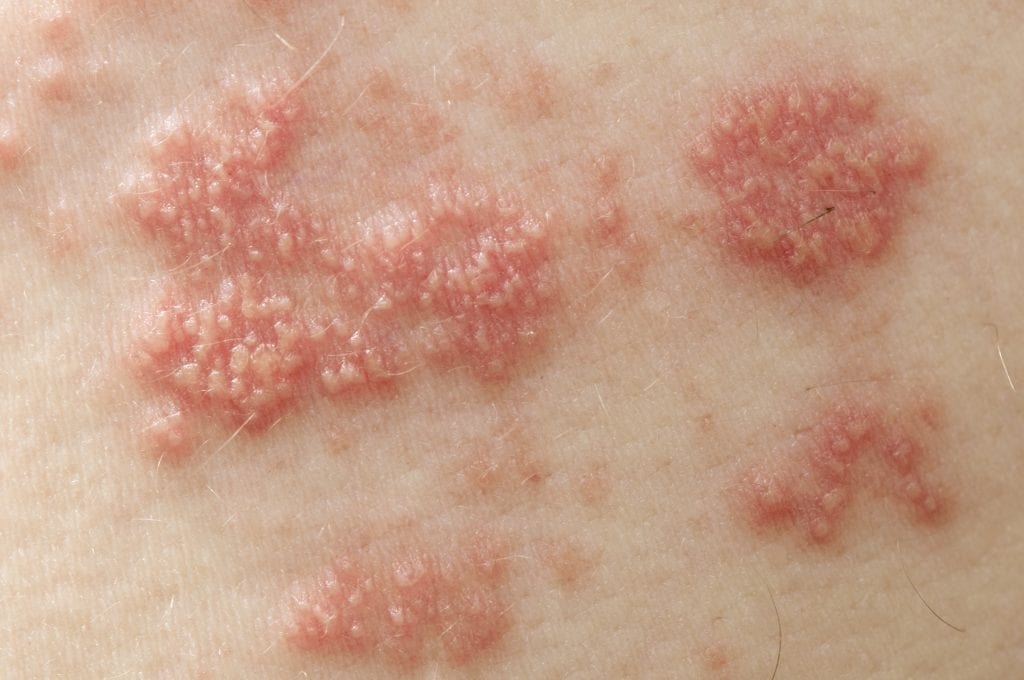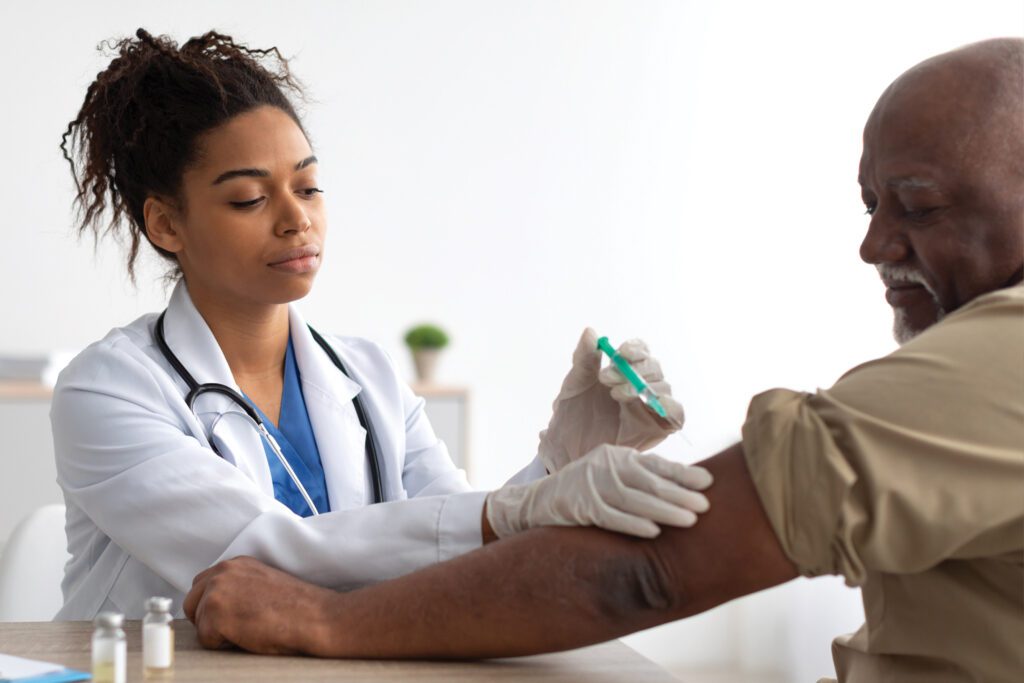How to Identify Shingles
One itchy red pimple above the ankle seemed like “just a bug bite” – until stabbing, searing leg pain caused a middle-aged woman to cry out in her sleep.
What looked like a single large pimple at the temple morphed into several more, causing a throbbing ache along the left side of a young mother’s face.
An elderly woman living alone never saw the telltale rash on her back side. She thought her acute back pain was more arthritis – until it became encephalitis.

Seek Protection with Vaccinations


The culprit in each of these cases was the varicella zoster virus (VZV), a painful skin rash commonly known as shingles or herpes zoster. This is not the virus that causes genital herpes, a sexually transmitted disease. Instead, VZV is responsible for an ailment familiar to nine out of 10 Americans over the age of 40: chickenpox. The itchy scabs of childhood chickenpox eventually disappeared, but the virus didn’t. It went undercover, lurking in nerve roots, waiting to reactivate whenever stress, injury, certain medicines or aging might weaken the immune system. If it gets a second chance, VZV causes shingles, not chickenpox.
The first signs of shingles may not even be noticed. Symptoms can include pain, itching, tingling and burning in an area, and a rash often appears a few days later.
The rash usually occurs on only one side of the face or body and frequently turns into blisters that scab after three to five days. Some people only get a mild rash, and some do not get a rash at all. Other symptoms can include fever, headache, chills and upset stomach. Weakness, dizziness, confusion and changes in vision can also occur.
Dr. Eric Carter of Hutcheson Family Care in Ooltewah says his office treats a case of shingles about once every two weeks. The majority of his shingles patients are elderly, but not all of them. “Less frequently, I see younger patients, sometimes in their late twenties, with relatively milder cases,” he says. “In general, I have seen smaller lesions affecting younger patients. Pain level has not been directly related to size of lesion. I’ve seen younger patients with small lesions expressing great discomfort.
“I think older age is a risk factor for increasing severity of illness,” he adds. “Recently, I evaluated a patient with facial involvement. This was a relatively severe case that caused severe pain. The affected patient was a 63-year-old female.”
Are women more likely to develop the disease? “In my practice, I have definitely seen the illness more often in women than men,” Carter says. “I do not think this reflects the actual population of people affected by the disease. Instead, I believe it reflects the possibility that women are more likely to see a physician for this particular presentation.”
Seek Medical Treatment Early:
Carter emphasizes the importance of seeking medical treatment early to shorten the duration of the outbreak and minimize long-term side effects. Several medications are available to treat shingles. He says he often prescribes the antiviral medication known as Valtrex.
“I like to give it within 48 hours of illness onset,” he says. “Acyclovir, another antiviral medication, is a generic alternative to the brand name Valtrex.”
The shingles rash can last for two to four weeks. For most people the pain lessens as the rash heals; however, one out of five patients will experience severe residual pain that can last for months, even years. This pain, known as post-herpetic neuralgia (PHN), is caused by damage done to the nerves from the virus.
“People can be surprised by the possibility of postherpetic neuralgia,” says Carter. “For most patients this is an academic issue because the vast majority will not suffer from this complication. Patients over the age of 50 are more likely to suffer from this complication.”
When they do, Carter has used a three-week course of systemic steroids for select patients. “Steroids, in some investigations, have been shown to reduce the incidence of postherpetic neuralgia,” he adds. “Of course, three weeks of steroids have their own set of consequences, and these side effects need to be considered.”
Other complications from shingles may include skin infections, muscle weakness, scarring, paralysis on one side of the face, a decrease or loss of vision or hearing, and allodynia, which is pain from a source that would not normally cause pain, such as a slight breeze over the skin or the touch of clothing. In rare cases, shingles can lead to pneumonia, brain inflammation (encephalitis) and even death.
The Centers for Disease Control and Prevention (CDC) estimates that 1 million Americans develop shingles each year. Almost half of those cases occur in adults 60 years of age and older. One out of two people living to age 85 will have shingles.
Anyone who has recovered from chickenpox can get the disease, even children; but those most vulnerable have immune systems weakened by cancer, leukemia, lymphoma and human immunodeficiency virus (HIV). People who receive immunosuppressive drugs such as steroids or drugs given after organ transplantation are also at increased risk.
Most people who develop shingles usually only get it once, although second and third cases have been documented. Shingles cannot be passed from one person to another. The varicella zoster virus can only be spread from a person with active shingles to a person who has never had chicken pox. That person would have to come in direct contact with the rash during the blister phase, not after it has crusted. The exposed person would then contract chickenpox, not shingles. People with shingles should keep the rash covered, not touch or scratch the rash, and wash their hands often to prevent spreading the virus.
Shingles Vaccine:
The best way to prevent transmission is to stop the disease before it begins. The Federal Drug Administration has now approved a vaccine to help prevent shingles, or to make it less painful if it strikes. In clinical tests involving 20,000 adults age 60 and older, the medication Zostavax reduced the risk of shingles by 51 percent and the risk of postherpetic neuralgia by 67 percent. While the vaccine was most effective in adults age 60 to 69 years, it also provided some protection for older groups.
The most common side effects reported were redness, soreness, swelling or itching at the shot site and headache. Less common side effects included allergic reactions, fever, joint and muscle pain and swollen glands.
Since it is made of a weakened form of the VZV or chickenpox virus, Merck pharmaceutical company recommends that patients receiving this immunization consult with their doctor if they expect to be in close contact with newborn infants, someone who may be pregnant and has not had chickenpox or been vaccinated against it, or someone who has problems with their immune system.
Carter recommends Zostavax for his patients over age 60 whose immune systems are not suppressed. “It will boost their immunity, regardless of whether or not they’ve had chickenpox,” he says.
For adults under age 60 who are unsure about their chickenpox status, a simple blood test can determine whether they have been exposed to the virus. “If they have not been exposed,” he says, “the varicella vaccine can be beneficial for most adults.” This vaccine is now part of the standard immunization schedule for children. It includes a dose at 12 to 15 months and a second one at four to six years.
“The most sensible piece of advice I have regarding shingles and chicken pox is to take advantage of the effective vaccinations that are available,” says Carter. “They reduce the incidence of disease and also the severity of infection, (even) if they fail to completely protect a patient from the disease.”
Current research suggests that the shingles vaccine is effective for at least six years and maybe much longer. Additional research will determine if the recommended age for vaccination should be lowered. The CDC, working with the FDA, will continue to monitor the safety of the vaccine.
Medicare Part D Plans cover the cost of the vaccine, less the patient copay. Medicare Part B Plans do not cover the shingles vaccine. For private insurance and Medicaid coverage, contact your provider. Both the shingles vaccine and chickenpox vaccine are available at the Hamilton County Health Department. To schedule an appointment, call Adult Immunizations at (423) 209-8340.

